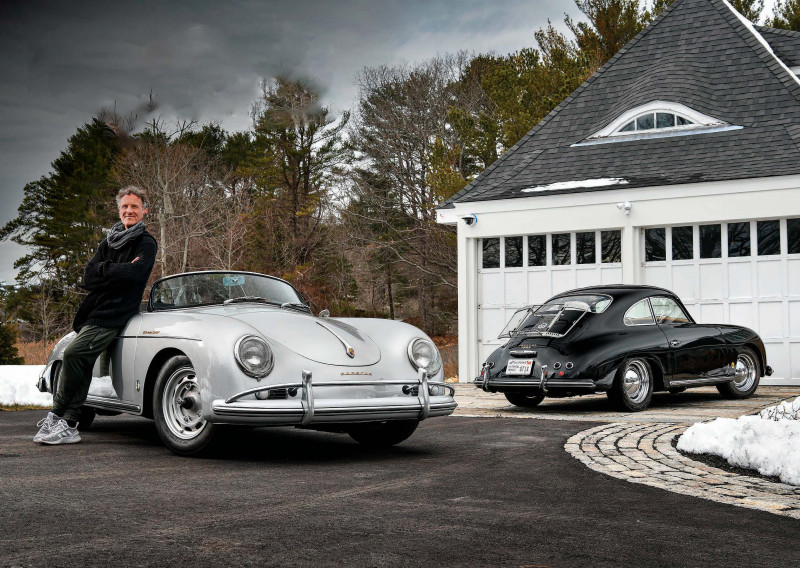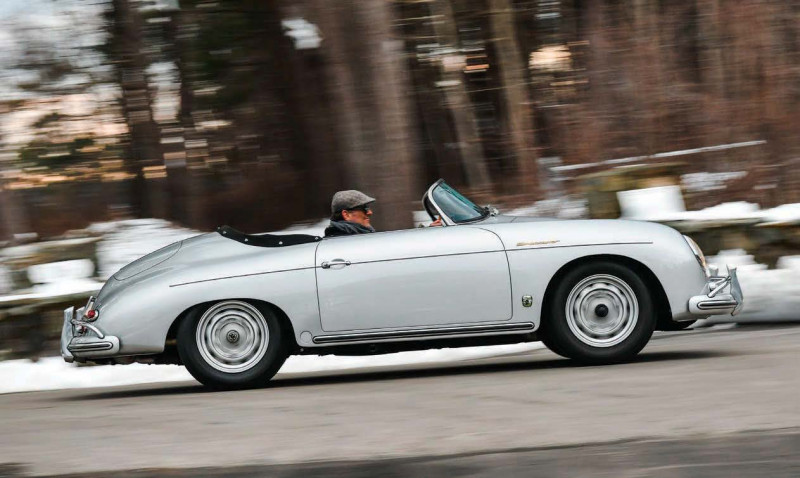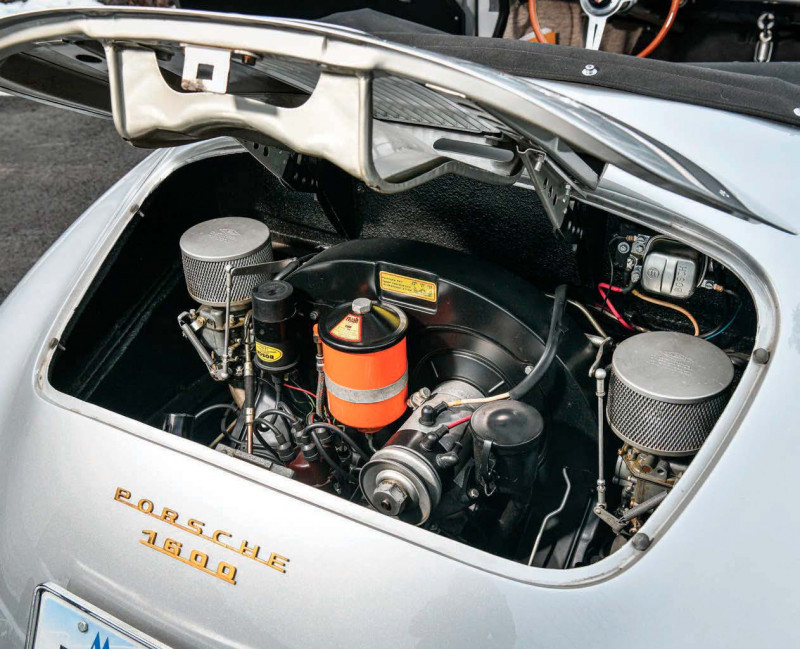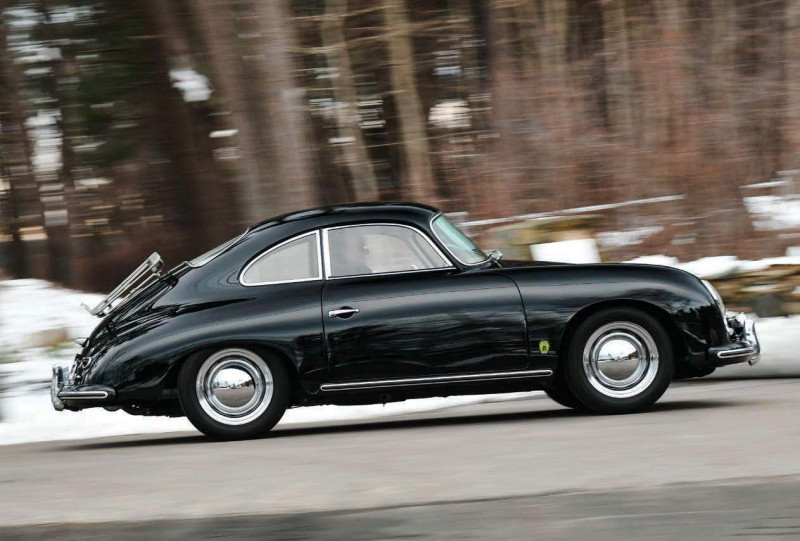Vivian Campbell’s Porsche 356 Speedster and Coupe
Soon after its introduction in late 1954, the 356 Speedster attracted many admirers from the world of entertainment. Fast-forward to the present day, and this open-top Porsche continues to captivate stars of the stage, as we discovered when visiting Def Leppard guitarist, Vivian Campbell, at his home in a snow-covered New England…
Words Dan Furr
Photography Chris Wallbank
STAR POWER
Vivian Campbell’s Porsche 356 Speedster and Coupe

During a time when feedback from an automotive manufacturer’s clients played an equally important role in the development of its cars as input from the engineers building them, the 356’s evolution was rapid, with model variants arriving annually to meet the demands and expectations of sales teams and Porsche’s growing customer base. Of course, 356 no.1 set the blueprint for what was to follow after Ferry Porsche presented the compact, mid-engined, two-seater roadster as the first product of the fledgling company bearing his family name. And yet, during the firm’s early, formative years, when new markets were opened and fresh models were created to appease small, but discerning and important groups of customers, Porsche managed to keep control of its product development strategy.

Engines received more power, disc brakes were introduced and suspension was tweaked in direct response to feedback from dealers and buyers, each only too happy to give Porsche their impressions of the 356 driving experience. New York-based European sports car importer, Max Hoffman, was chief among those eager to let Ferry know where Porsche could be improving its cars. Specifically, Hoffman recognised the need for a track-ready 356 aimed squarely at the growing North American club racing scene. His suggestion set in motion a chain of events resulting in the 356 Speedster, a Porsche designed for circuit action at weekends and regular driving duties Monday to Friday.
Based on the 356 Cabriolet, the Speedster’s significantly lower price tag was achieved through a combination of eliminated creature comforts, a rain cover and a shorter (and removable) windscreen. Focus on driving dynamics and a slinkier look ensured the model was an instant hit in sun-drenched California, where the 70bhp 1500 Speedster was bought by many enthusiastic amateur racing drivers.
In 1957, the model reached its peak with launch of the 356 A 1500 GS (Grand Sport) Carrera GT Speedster. Featuring the now legendary Ernst Fuhrmann-designed Type 547 1.5-litre, vertical-shaft, four-cam engine beneath its rear deck, the Speedster was now a 110bhp flyer, earning the model the honour of being the first of the manufacturer’s production cars to break the 200km/h (124mph) barrier. Less than two years later, the 356 Speedster’s days were done, but production volume of more than three thousand cars proved Hoffman’s idea was inspired, building on his previous form for recognising lucrative gaps in a crowded marketplace — the Austrian entrepreneur was also responsible for sowing the seeds leading to thecreation of the W198 Mercedes-Benz 300 SL ‘Gullwing’ and the forefather of all Porsche Speedsters, the 356 America Roadster, an aluminium-bodied, lightweight US-only model introducing slot-in windows, bulk-free buckets and a folding rain cover.

Sadly, the expensive Porsche proved to be a commercial disaster, with only sixteen units built and coachbuilder, Heuer-Glaser, driven to bankruptcy due to losing money through sky high production costs on each America Roadster sold. The blueprint for the Speedster, however, was set, and with Hoffman’s efforts in the USA accounting for a third of all Porsches sold, his ideas were taken seriously by Ferry’s team in Stuttgart.
THE SPEEDSTER WAS AN INSTANT HIT WITH SOUTHERN CALIFORNIA’S SCCA RACING SET
The Speedster was an instant hit with Southern California’s SCCA racing set, but the little Porsche also caught the eye of Hollywood glitterati — famous 356 Speedster owners included actors, James Dean and Steve McQueen. Indeed, The King of Cool’s first new car was a 356 Speedster 1600 Super. At the time, McQueen was proving his credentials as a capable wheelman in motorcycle racing (he once famously quipped, “I’m not sure whether I’m an actor who races, or a racer who acts”), but with a steady stream of income from television, theatre and the movies reaching his bank account, he found himself in the fortunate position of being able to buy a box-fresh Speedster before Porsche discontinued production in 1958.
THE CAR’S THE STAR
The model’s association with stars of stage and screen has helped it become one of the most desirable collector Porsches, but don’t think the entertainment world’s love of the Speedster ended with cessation of manufacturing — surviving examples of the air-cooled classic have continued to be a mainstay of the film world, making cameos in many high-profile movies and television shows. Moreover, a high number of today’s privately owned collections of historic Porsches include a 356 Speedster.
And so it is with the exquisite fleet of Stuttgartcrested sports cars owned by legendary guitarist, Vivian Campbell, best known for his role as axeman in rock band, Def Leppard. As I discovered during a trip to meet Viv at his home in New England, however, a Speedster isn’t the only special 356 to carry the Campbell name on its logbook.

Before we delve into the detail, a history lesson is in order. It’s widely known Viv joined Def Leppard in 1992 following the untimely death of the band’s original guitarist, Steve Clarke. After being officially introduced as a full-time member of the group at the Freddie Mercury Tribute Concert for AIDS Awareness at Wembley Stadium on 20th April that year, Viv began touring with his new bandmates to support the Adrenalize album, but prior to his now more-than-three- decade service with Joe and co., he was a member of the hugely influential rock and metal groups, Thin Lizzy, Whitesnake and Dio. Today, in addition to his punishing work schedule with Def Leppard, he’s a member of power rock four-piece, Last in Line, formed with his former Dio colleagues.
Viv’s first Porsche was a Grand Prix White 964 Carrera 2, bought not long after he joined Def Leppard. “Its original owner was a lawyer working out of Los Angeles,” he reveals. “Previously, as the owner of a Ferrari 308 GTB, I mistakenly considered Porsches a little boring, especially when compared to the output of Italian sports car manufacturers. To my mind, the 911 looked dull, lacking the design flair exhibited by cars rolling out of Maranello, but the makeover Porsche gave the 964 blended the 911’s traditional styling with a contemporary look, which appealed to me. The 911 finally looked modern.”
Aesthetics are one thing, but as Viv soon discovered, the real difference between a 911 and its contemporaries is the driving experience. “It was nothing short of amazing,” he admits. “Here was a sports car I could actually use in anger, unlike the Ferrari, which looked great and was a lot of fun, but didn’t really drive too well. I was immediately hooked on the 964 and quickly began to appreciate the simplicity of design Porsche had adopted throughout its history.”
The white wonder sparked his long and fruitful relationship with Stuttgart’s finest, which led me to enlist the services of my trusty photographer, Chris Wallbank, and fly to the eastern seaboard, where some of Viv’s collection resides. Interestingly, his fleet is split pretty evenly between air-cooled and ‘kettles’ — his later Porsches include a 996 GT3 RS (a rare sight in America due to the model not being offered to the US domestic market), a modified 997 GT3 RS 3.8, a 991 GT3 and a 991 GT3 RS, all of which are used almost exclusively on track days whenever Viv is home from touring. Additionally, he owns a 997 GT3 RS 4.0, which resides in Los Angeles.
As for the air-cooled cars taking his fancy, he owns a gorgeous 1967 911 S finished in Aga Blue, plus the two 356s pictured on these pages. We’ll come to those in a moment. The aforementioned 964 is long gone, though. “I hugely regret selling that Porsche,” he grimaces. “I’ve long lamented my decision to part with it. In fact, lingering seller’s remorse is why I’m loathed to get rid of cars, Porsche or otherwise.”
We’re sure the high standard of vehicle in his possession is also a contributing factor in not wanting to say goodbye to any of his fantastic four-wheelers. Talking of which, Emory Motorsports is currently building Viv a 356 Outlaw based on a non-running 1953 bent-window coupe. The finished asphalt attacker is set to be powered by a Rothsport Racing engine and, unusually, has been specified with a sunroof (“it gets hot here in summer”). The build is in its early stages, and although overall specification is yet to be finalised, we look forward to seeing the results of what promises to be a pleasingly collaborative project.
Meanwhile, Singer Vehicle Design has allocated one of its last non-Turbo build slots to the legendary axe-wielder following his visit to the company’s newly established headquarters in Torrance. “A mutual friend introduced me to Singer founder, Rob Dickinson, by email,” Viv explains. Once again, the world of Porsche and guitar music collide — not only was Rob vocalist with indie band, Catherine Wheel, he is cousin of Iron Maiden frontman, Bruce Dickinson.
And you thought the Singer name was purely a tribute to a celebrated Porsche motorsport engineer named Norbert?! “Rob invited me to check out Singer’s new 115,000ft2 production base,” Viv continues. Consolidating six separate, smaller facilities and more than doubling the size of the firm’s footprint in California, Singer’s new factory was established in response to growing demand for the brand’s restoration services. Amazed at the scale of the operation, not to mention its laboratory-like cleanliness, but well aware the company is now only taking orders for reimagined 964s based on the high-profile 2022 Singer Turbo Study, Viv was part disappointed, part relieved not to be tempted by the availability of a build slot for one of Singer’s classic builds — all of the cars in the Campbell collection are normally aspirated. Its master intends to keep it that way.
“I joked about being too late to place an order for one of the company’s non-Turbo 911s, only for Rob to reveal one of the very last examples scheduled for assembly was subject to a cancelled order.” How could Viv resist?! Dubbed the Ireland Commission (until a less wide-reaching name can be agreed) on account of his nationality, the Singer build forms part of a trio of currently in-progress projects destined to land on Viv’s driveway, the third being a hardcore R4 rally car he describes as “a Mitsubishi Mirage on steroids”.
Back to the here and now, though. We’ve got 356s to play with, after all. Chassis 84404 is a 1958 Type 2 Speedster bought by Viv from CPR Classic, an independently owned and operated air-cooled Porsche restoration specialist in Fallbrook, California. Restored by the company’s talented technicians, the car wears its original colour of Silver Metallic. “It’s a numbersmatching 356, complete with its original 1.6-litre flat-four,” Viv smiles. “I bought the Porsche in 2019. I subsequently took it on a road trip from Palm Springs to Hollywood, the long way round. I must have covered seven hundred miles that week. All the car needed was fuel and a top-up of oil, although I was soon made aware of how cold it can get up in the mountains. Put it this way, driving in Los Angeles and the surrounding area is all about canyon roads — the warmth of a coupe cabin can quickly prove itself beneficial.”
COAST TO COAST
Of all Viv’s Porsches, his immaculate Speedster is the one he drives most regularly, especially following his relocation from the West Coast to New England. “It’s my go-to Porsche. It’s a huge amount of fun. My wife, Cait, and I love taking this car out for leisurely cruises along local coast roads. It’s also a big hit with my rescue dog, Stuart, who loves being a passenger during open-top motoring. Having said all this, I love Porsches with patina. You could argue the restoration of this car is too good — there’s no way Porsche made Speedsters this well back in the fifties.” All credit to CPR.
Interestingly, the silver stunner was originally specified with Comfort seats, though traditional Speedster pews are now in place. In fact, CPR did such a good job of affording the car a new lease of life, Viv has no plans other than to simply maintain and enjoy it. And in his adopted neck of the woods, there’s no shortage of like-minded petrolheads to share in his passion for Porsche. “There’s strong car culture here in New England,” he confirms. “Obviously, the same is true of California, particularly in the south of the state, but the scene is more varied where I’m now living, with more appreciation for a wider variety of marques.”
While I have no reason to doubt him, heavy affection for Porsche is clear to see in this part of North America — during my stay, whenever I take to the road in my decidedly non-Porsche rental vehicle (one of those Mazda SUVs seemingly used as inspiration for the design of Ferrari’s new Purosangue), it doesn’t take long to spot a 911. And, it should be noted, while Viv’s fleet comprises an impressive fifteen cars (Porsches form the nucleus of the collection, supported by legacy models from Jaguar and Alfa Romeo), there are many vast, privately owned collections of premium sports cars in this corner of America. Barns full of them, in fact. Porsches rank high among the inclusions. Save for its seats, Viv’s Speedster has been restored to original specification.
The same can’t be said for his jet black 1956 356 A Type 1 coupe, which he bought in 2016 after spotting it advertised through Fantasy Junction, an Emeryvillebased broker of special interest and collector cars. “It looked so pretty,” he recalls. As his musings concerning old Ferraris attests, he’s a very visual guy, though I’ll wager any Porsche enthusiast would find it difficult to consider this particular tin-top as anything other than stunning. “The car didn’t sell, remaining listed with the dealer for many months. In the end, I decided to take a punt and bought it sight unseen, albeit after Emory Motorsports founder, Rod Emory, carried out an inspection on my behalf.”
Delivered new to its first owner in the USA on May 15th 1956 and wearing black paintwork over a tan interior, the car was optioned with Super engine number 80321, Continental tyres, ‘Super 1600’ badges and chrome wheels. Subjected to exhaustive cosmetic and mechanical restoration prior to Viv’s ownership, the car was treated to a raft of choice modifications at the same time, including the appointment of a 1.7-litre oversized flat-four based on the powerplant of a 1966 912. In case you were wondering, the original engine remains with the car and is currently in storage.
The vast majority of the restoration work was carried out by 356 expert, Ted Blake, between 2003 and 2008. The body rejuvenation included new floor pans, longitudinals and a fresh battery box. Blake also installed new wiring and fluid transfer pipes, plus the engine, transmission, steering components, suspension and braking equipment. A new wiring harness was supplied by YnZ’s Yesterday’s Parts. A new six-volt starter motor was also sourced.
HEART OF THE MATTER
The uprated boxer was built by Duane Spencer’s Shasta Designs and uses the stock 912 crankcase (line bored), rods and crankshaft, along with new rod and main bearings, a fourteen-pound flywheel, a high-flow oil filter, re-ground camshafts, new Shasta pistons and cylinders, rebuilt cylinder heads, new guides, reground valves, new pushrods and tubes, rebuilt Solex carburettors, a rebuilt 912 fuel pump and the car’s original 1600 Super tinware, which has been restored and powdercoated.
The transmission is from a 356 B and was rebuilt by Vic Skirmants of 356 Enterprises in North Branch, Michigan, with all new bearings, tubes, synchros, differential carrier, axle boots, clamps, remanufactured driveshafts and new shift hardware. The braking system makes use of a dual circuit conversion kit from Klasse 356, while new Koni shocks and one of the suspension giant’s steering damper and anti-roll bar bushing kits were installed alongside a remanufactured (and updated) ZF steering box.
As you’d expect, the fuel tank was restored, as was external lighting and badges. The dash gauges were rebuilt by Palo Alto Speedometer, and all interior and exterior rubbers were replaced. An extremely sharplooking 356 with extra punch, this black beauty went on to score second-in-class at the Neillo Concours at Serrano following completion of the restoration work. “Driving lights and bumper-exit exhausts were also added to the car,” Viv explains. The keen-eyed among you may have noted it rolls on 5.5-inch wheels, as opposed to the original 4.5-inch rims. “Behind them are drum brakes, which is my only real complaint about the 356 driving experience. These are surprisingly fast cars for their age, but the standard brakes let them down. My Speedster is really quick because there’s nothing to it. The coupe is heavier, obviously, but is being propelled by an engine with higher output. Consequently, there’s not much difference in performance between these Porsches, but if they had more urgent braking systems, they could be driven much harder on the public road.”
LOGICAL PROGRESSION
It could be argued the modern GT Porsches in Viv’s collection are the ultimate evolution of what we see here. Despite the fact the Speedster was the lairy Porsche of its day, however, he finds both his 356s relaxing to drive. “I love how engaged I am in the mechanical process of these cars,” he tells me. “I have to be — they demand attention from behind the wheel. I really don’t enjoy driving my newer Porsches away from the track, where they truly come alive, whereas these 356s are perfect for country roads by the coast, as well as strips of asphalt carving through mountains. I also enjoy just how much other road users appreciate seeing old Porsches. Guys wave, girls smile. By contrast, if I’m in one of my GT3s or an RS, nobody wants to let me out of a junction.”
Complete with wood-rimmed steering wheel, tinted sun visors, luggage rack and period-correct Blaupunkt radio, the coupe had covered little more than five hundred miles between completion of the restoration and Viv signing on the dotted line. Its odometer currently reads 3,174, proving this is an enthusiast who isn’t afraid to put his Porsches through their paces. “This is the cleanest they’ve been under my watch,” he laughs, in recognition of our photoshoot encouraging detailing session, when his true desire is to get out and drive whenever he’s home from touring or studio work, of which he is presently heavily occupied.
On that note, following on from Def Leppard’s well-received 2022 album, Diamond Star Halos, the world will see rock and classical royalty unite on the band’s follow-up, Drastic Symphonies. Due for release on May 16th, this brand-new album features many of the group’s greatest hits dramatically reimagined by way of collaboration with The Royal Philharmonic Orchestra. By and large, original recordings from Def Leppard’s back catalogue have been deconstructed, then bolstered with new vocal and guitar tracks to complement symphonic arrangements. At different points, you can even hear main man, Joe Elliott, duetting with his younger self.
Mere days after Drastic Symphonies is released, Def Leppard kicks off the next leg of its mammoth co-headline stadium tour with American glam rockers, Mötley Crüe. The tour has sold an astonishing 1.3 million tickets thus far. In fact, it was during downtime between shows in Latin America and mainland Europe I got to spend time with Viv at his home in the USA. And, as if he isn’t busy enough already, his other currently active band, Last in Line, has just released new album, Jericho, supported by a launch gig at the Hard Rock Café in Las Vegas just as this issue of Classic Porsche went to press.
We’ll be featuring Viv’s water-cooled Porsches in the next issue of our sister title, 911 & Porsche World (subscribe online ). What of the future for his air-cooled cars? “I’ll just top-up the oil and keep them sweet,” he shrugs. “I’d love to build a sizeable collection of modern RS-badged 911s, but the old stuff never fails to distract me. Put simply, 356s are too enjoyable to ignore.”
Like many buyers who were lucky enough to sample the Speedster’s carefree character when new, Viv appreciates he is charge in a very special early Porsche. The 356 was a breed apart from every other vehicle being produced in post-war Europe, and as his delightful drop-top and devastatingly cool coupe ably demonstrate, the model is just as desirable today as it ever was.
THE 356 WAS A BREED APART FROM EVERY OTHER VEHICLE BEING PRODUCED IN POST-WAR EUROPE
Above A superbly modified coupe or a standard Speedster? Which of these 356s would you like to see parked on your driveway? Right Engine is a 1.7-litre boxer based on a 1966 912 lump, with the original flatfour kept safely in storage Below Viv has been very busy, evidenced by new albums from both Def Leppard and Last in Line, plus a mammoth stadium tour, of which the European leg is about to kick off following sell-out shows in the USA and Latin America.
IT COULD BE ARGUED THE MODERN GT PORSCHES IN VIV’S COLLECTION ARE THE ULTIMATE EVOLUTION OF WHAT WE SEE HERE
Above Viv bought his cool coupe sight unseen, though had reassurance from Rod Emory, who inspected the car prior to purchase.
Above Chassis 56380 is a 1956 Type 1 coupe modified to give the car more punch, without negatively impacting the traditional 356 feel Below Two very different 356s, but cars perfectly complementing one another.
SINGER VEHICLE DESIGN HAS ALLOCATED ONE OF ITS LAST NON-TURBO BUILD SLOTS TO THE LEGENDARY AXE-WIELDER
Above New England’s superb coastal roads are now home to this air-cooled classic, which gets plenty of use.
VIV’S FIRST PORSCHE WAS A GRAND PRIX WHITE 964 CARRERA 2, BOUGHT NOT LONG AFTER HE JOINED DEF LEPPARD
Above 1.6-litre flat-four is original to the car, which was expertly restored prior to Viv taking ownership. Above Viv’s Speedster was originally specified with Comfort seats, but now makes use of trimmed buckets most often associated with the model Below Editor Dan and Viv chatting cars and guitars
Above Chassis 84404 is a Type 2 Speedster from 1958, the model’s final year, and is the Porsche its proud owner drives more than any other in his collection


